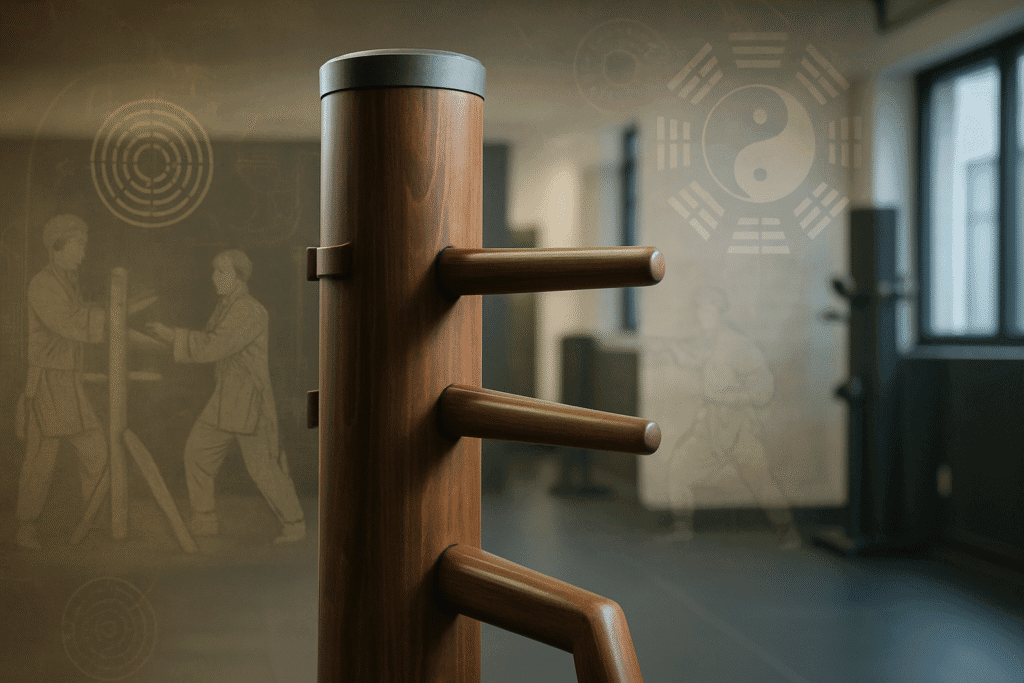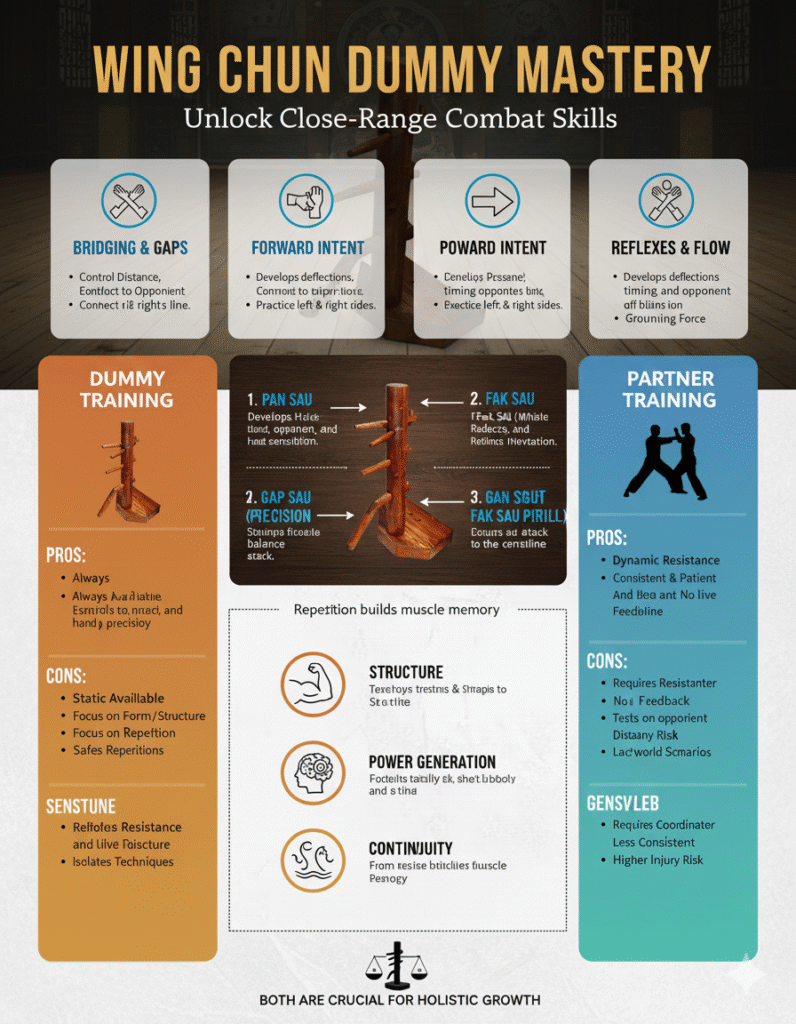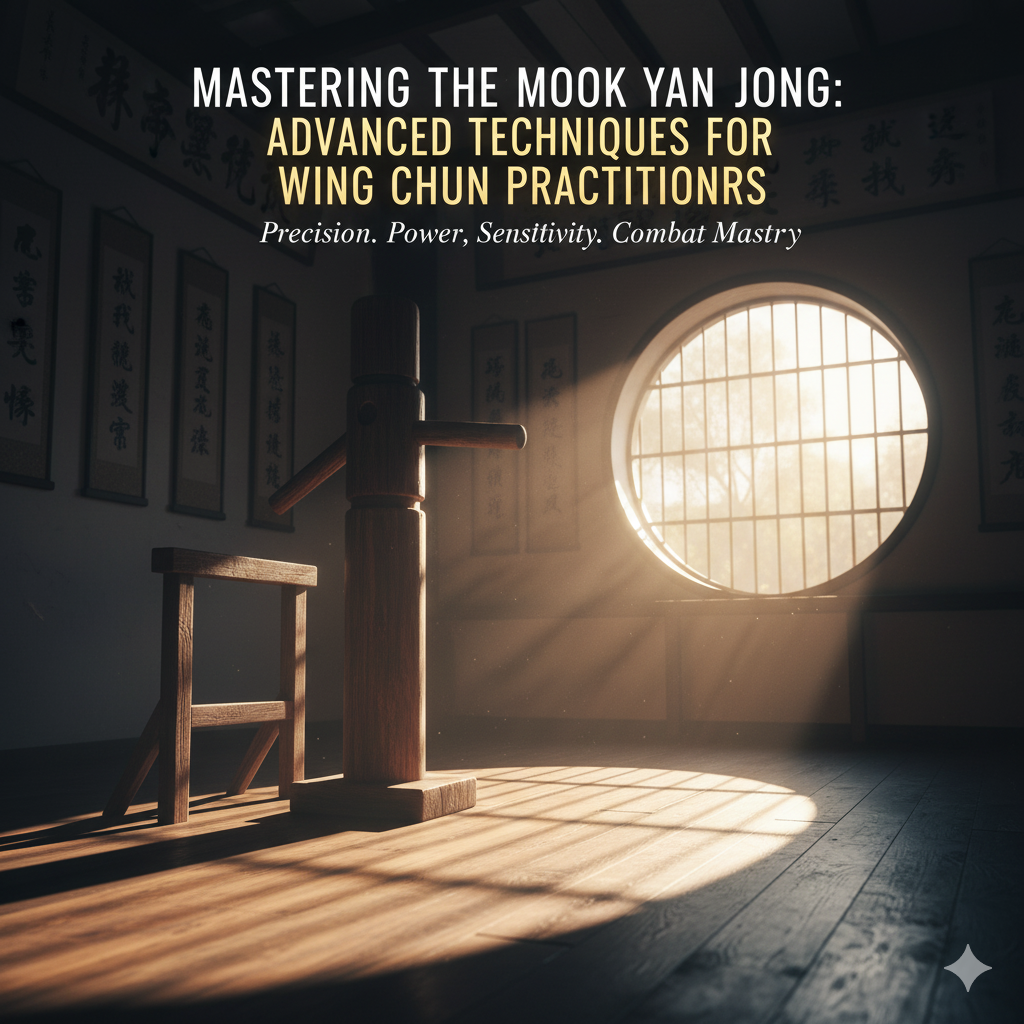For centuries, martial artists have sought ways to refine their techniques, develop power, and cultivate precision.
Among the myriad training tools, one stands out for its iconic presence and profound impact:
the Mook Yan Jong, or Wooden Dummy.
This seemingly simple wooden apparatus has been a cornerstone of Wing Chun kung fu training for generations, but its influence extends far beyond its traditional roots.
Today, the Mook Yan Jong continues to evolve, finding new applications and relevance in the diverse landscape of modern martial arts.
Join me as we explore the fascinating journey of this remarkable training partner, from its humble beginnings to its dynamic role in contemporary martial arts practice.

Videos are added as random thoughts 💭 💭 💭…
The Roots of the Wooden Dummy: A Historical Journey
The exact origins of the Mook Yan Jong are shrouded in a bit of mystery, as is often the case with ancient martial arts traditions.
However, it is widely believed to have originated in Southern Chinese martial arts, most notably Wing Chun kung fu [1].
The wooden dummy, or ‘Mu Ren Zhuang’ in Mandarin, was designed to simulate a human opponent,
allowing practitioners to train various techniques without needing a partner.
Early versions were likely simpler, evolving over time to the sophisticated form we recognize today.
One popular theory suggests that the Mook Yan Jong was developed by the legendary Buddhist nun Ng Mui,
one of the Five Elders of Shaolin Temple, who is credited with creating Wing Chun.
Another theory links its development to the Red Boat Opera troupes, where martial artists adapted their training methods to the confined spaces of the boats [2].
Regardless of its precise genesis, the Mook Yan Jong became an indispensable tool for developing crucial Wing Chun principles such as centerline theory, simultaneous blocking and striking, and efficient footwork.
It allowed practitioners to hone their forms, practice combinations, and build sensitivity to angles and pressure, all vital components of the Wing Chun system.
From Tradition to Innovation: The Mook Yan Jong in Modern Martial Arts
While the Mook Yan Jong is most famously associated with Wing Chun, its principles and the benefits of training with a static, human-like form have transcended its original context.
In modern martial arts, we see the influence of the wooden dummy in various forms,
even if not always in its traditional wooden structure.
The core idea of developing precision, timing, and power against a fixed target remains incredibly valuable.
Today, the Mook Yan Jong is not just a historical artifact;
it’s a dynamic tool that continues to adapt. Modern martial artists, including those in disciplines like Jeet Kune Do, Krav Maga, and even some MMA practitioners, utilize similar concepts.
They might use heavy bags, specialized training dummies,
or even wall-mounted targets to simulate the angles and resistance offered by the Mook Yan Jong.
The emphasis has shifted from strictly adhering to Wing Chun forms to extracting the underlying principles of efficiency and directness that the dummy teaches.
Furthermore, the Mook Yan Jong has found a new life in the digital age.
Online courses and instructional videos now make Mook Yan Jong training accessible to a global audience,
allowing practitioners to learn techniques and drills from the comfort of their homes [3].
This accessibility has democratized the training, moving it beyond the confines of traditional kwoons and into the hands of anyone with an internet connection and a desire to improve their martial arts skills.
Beyond the Form: The Benefits of Mook Yan Jong Training Today
The Mook Yan Jong offers a unique set of benefits that are highly relevant to modern martial arts training, regardless of style.
It’s not just about learning a specific form; it’s about developing fundamental attributes that translate to real-world application.
Here are some key advantages:
Precision and Accuracy: Unlike a moving opponent, the wooden dummy provides a fixed target, allowing practitioners to repeatedly drill techniques with pinpoint accuracy.
This develops muscle memory for precise strikes, blocks, and deflections.
Structure and Alignment: Training with the Mook Yan Jong forces the practitioner to maintain proper body structure and alignment.
The unyielding nature of the dummy immediately highlights flaws in posture or technique,
encouraging the development of a strong, stable base.
Timing and Flow: While static, the dummy allows for the practice of continuous flow and timing.
The various arms and leg simulate different attack angles, requiring the practitioner to smoothly transition between techniques and maintain rhythm.
Power Generation: The solid resistance of the Mook Yan Jong helps in developing explosive power.
By striking and applying force against a firm object, practitioners learn to generate power from their entire body, not just their arms.
Sensitivity and Bridging: The wooden dummy is excellent for developing ‘chi sao’ or ‘sticking hands’ like sensitivity.
Practitioners learn to feel for openings, maintain contact, and respond to pressure, which are crucial skills for close-range combat.
Mental Focus and Discipline: Training with the Mook Yan Jong requires intense concentration and discipline.
The repetitive nature of the drills, combined with the need for precision, fosters mental fortitude and a deeper understanding of the techniques.
These benefits extend beyond traditional Wing Chun, making the Mook Yan Jong a valuable cross-training tool for any martial artist looking to enhance their fundamental skills and understanding of combat principles.
Conclusion
The Mook Yan Jong, or Wooden Dummy, is far more than just a piece of training equipment;
it’s a testament to the enduring wisdom of martial arts traditions.
From its mysterious origins in Southern China to its modern-day adaptations and global reach,
the Mook Yan Jong has consistently proven its value in developing essential martial attributes.
Whether you’re a dedicated Wing Chun practitioner or a martial artist from another discipline looking to deepen your understanding of precision, power, and flow, the wooden dummy offers a profound and rewarding training experience.
Its evolution reflects the dynamic nature of martial arts itself, constantly adapting while holding true to timeless principles.
Embrace the legacy, and let the Mook Yan Jong guide you on your journey to martial mastery.



